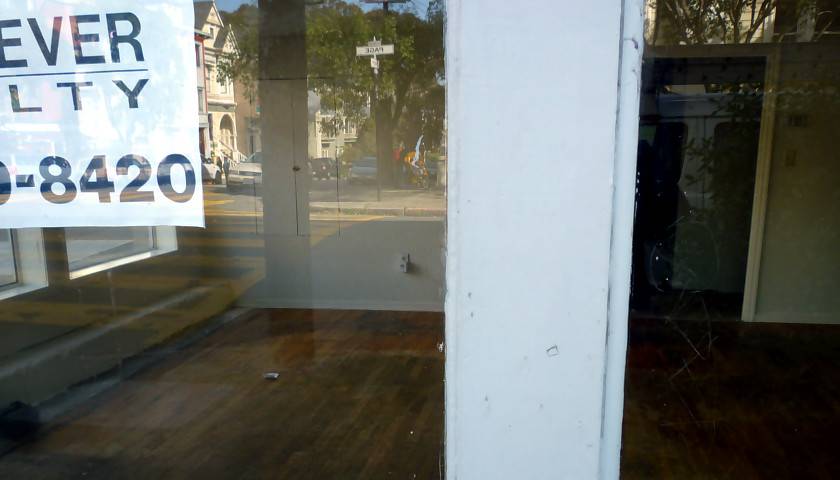by Will Kessler
The commercial real estate sector is facing the possibility of a substantial number of bankruptcies that could ultimately hamper economic recovery and threaten the wounded banking industry, according to experts who spoke to the Daily Caller News Foundation.
Overall 30 day+ delinquencies on commercial mortgage-backed securities (CMBS), meaning the number of borrowers for commercial properties that failed to make a required payment in at least the last 30 days, increased from 2.96 percent from one year ago to 4.63 percent as of October, according to a report from market research group Trepp. The delinquencies are indicative of danger in the commercial real estate sector, as they indicate that many of those could become bankruptcies, threatening an already hurting banking industry and exacerbating any economic downturn, according to experts who spoke to the DCNF.
“Commercial real estate is in deep trouble and could constitute a major risk to the banking system and the recovery,” Desmond Lachman, a senior fellow at the American Enterprise Institute, told the DCNF. “In fact, I would characterize the situation as a slow-moving train wreck. The underlying problem is that occupancy rates have slumped post-Covid since many workers are now working at least part of the time from home.”
 Vacancy rates for offices have continued to trend up since the COVID-19 pandemic, which forced many businesses to adopt remote work to continue operations — a change many workers have been reluctant to let go of, according to a report from Cushman & Wakefield. In 2019, the vacancy rate hovered around 13 percent and has increased to around 20 percent as of the third quarter of 2023.
Vacancy rates for offices have continued to trend up since the COVID-19 pandemic, which forced many businesses to adopt remote work to continue operations — a change many workers have been reluctant to let go of, according to a report from Cushman & Wakefield. In 2019, the vacancy rate hovered around 13 percent and has increased to around 20 percent as of the third quarter of 2023.
“The pandemic was an aggravating force that gave the shift from brick-and-mortar to laptop purchasing critical mass 20 years after it began,” Peter Earle, an economist at the American Institute for Economic Research, told the DCNF. “People, even (and especially) those who were suspicious of internet retail or liked the in-person shopping experience, were forced to move their consumption online during lockdowns and under stay-at-home orders. Many of them liked it, came to trust it, and now see little reason to go back to physical establishments.”
Delinquency rates for offices have seen the largest jump among commercial real estate, rising from 1.75 percent on 30 day+ delinquencies last year to 5.75 percent as of October 2023, according to Trepp. Industrial property delinquencies increased from 0.43 percent to 2.56 percent, and multifamily property delinquencies increased from 0.85 percent to 2.64 percent over that same time frame.
Retail delinquencies over the past year have managed to remain mostly stable as they are not hampered by factors like an increasing number of remote workers, according to Trepp. Despite being stable, delinquency rates for retail measured 6.55 percent in October 2023, lower than one year ago when it was 6.66 percent, but still greater than any other category in commercial real estate.
“To the extent that a commercial real estate slump creates job losses among staffers and maintenance people, a recession will be exacerbated by bankruptcies or liquidations,” Earle told the DCNF. “The longer-term effects, which would include canceling planned construction or freezing existing projects, would impact the building and materials industries as well. Further negative impacts could materialize if regional banks, which have lent substantial amounts to commercial real estate builders and owners over the past decade or two, find themselves mired in rising loan defaults.”
U.S. banks outside of the top 25 in assets hold around 37.6 percent of all loans but hold an astonishing 67.2 percent of all commercial real estate loans as of March, according to Axios. As of the last quarter of 2022, 40 percent of loan officers were tightening their lending standards in the commercial real estate sector as the industry becomes a riskier bet.
Small and medium-sized banks have been the cause of concern for some following a banking crisis at the beginning of 2023. Silicon Valley Bank collapsed after a bank run in March, with Signature Bank and First Republic Bank following suit, leaving many regional banks to struggle as depositors fled to larger banks that they believed would be a safer bet.
WeWork's $47 billion collapse could be the straw that breaks regional banks.
It could put nearly 600 commercial leases on the block, sticking the landlords — and their banks — with the bill.
Commercial real estate accounts for 30% of regional bank loans — roughly $300 billion.… pic.twitter.com/jxXlDQp6qK
— Peter St Onge, Ph.D. (@profstonge) November 17, 2023
“All of this is particularly bad news for the regional banks since as much as 18 percent of loans are made to this sector,” Lachman told the DCNF. “If the regional banks have to restrict lending because they are having large loan losses, this could spell trouble for the small and mid-sized companies that are hugely reliant on the regional banks for their credit. And those small and mid-sized companies account for close to half of overall employment.”
The Federal Reserve has raised its federal funds rate to a range of 5.25 percent and 5.50 percent, the highest rate in 22 years, after a series of 11 hikes that began in March 2022 in an effort to combat inflation. Inflation peaked at 9.1 percent in June 2022 and has since decelerated to 3.2 percent in October, far higher than the Fed’s 2 percent target.
Amid fears about the struggling industry, lending for commercial and multifamily mortgages dropped 49 percent year-over-year in the third quarter of 2023, according to Market Insider. The slowdown could be increasingly felt by the broader economy over the next few years, with around $1.5 trillion in debt needing to be paid back as the possibility for defaults increases.
“I think that the commercial real estate sector is a major risk to the economic recovery and that the Fed and the markets do not seem to be paying sufficient attention to this matter,” Lachman told the DCNF.
– – –
Will Kessler is a reporter at Daily Caller News Foundation.
Photo “Empty Storefront” by Gerry Brague CCNCSA2.0




